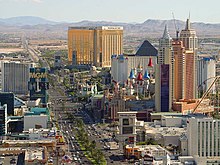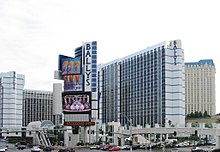Martin Stern Jr.
Martin Stern Jr. | |
|---|---|
| Born | April 9, 1917 |
| Died | July 28, 2001 (aged 84) |
| Occupation | Architect |
Martin Stern Jr. (April 9, 1917 - July 28, 2001) was an American architect who was most widely known for his large scale designs and structures in Las Vegas, Nevada. He is credited with originating the concept of the structurally integrated casino resort complex in Las Vegas.[1][2]
High-rising Las Vegas
[edit]
Martin Stern Jr. designed the International Hotel, which later became the Las Vegas Hilton, and the first MGM Grand Hotel and Casino, two pivotal Martin Stern Jr. projects with entrepreneur Kirk Kerkorian in 1969 and 1973, which set the pace for the transformation of Las Vegas from a low-rise sprawl[3] of motels, clubs and parking lots into an extravagant high-rise metropolis.
The Daily Telegraph (London) wrote of the first Stern and Kerkorian project in its September 2001 eulogy[4] to Stern: "The International, whose tri-form 30-floor tower contained 1,519 rooms and became the most imitated building on the Las Vegas Strip, provided the model for the Bellagio, Treasure Island, Mirage and Mandalay Bay, among other hotels." When it was completed, the International was the largest hotel in the world.
The first MGM Grand, with more square footage than the Empire State Building[2] and in its turn the largest hotel in the world, burned in 1980 in what is considered the worst disaster in Nevada state history. As the Telegraph observed, this loss only seven years after the hotel was completed was devastating to Stern. The MGM Grand was nonetheless rebuilt within eight months and reopened. It was sold in 1985 and rebranded as Bally's and is now Horseshoe Las Vegas.
Construction magnate Del Webb was another major client with whom Stern worked on many projects, including twenty years of elaborate stages of expansion of the Sahara Hotel and Casino between 1963 and 1983.[5]
Commissions
[edit]The extensive Lied Library and Architecture Studies Library inventories[6][7][8][9] of the University of Nevada, Las Vegas Department of Special Collections[10] document more than one hundred Martin Stern Jr. projects between 1951 and 1989, several of which — including the near-legendary Xanadu envisioned in 1975[1][6] — were never built. Dreaming the Skyline: Resort Architecture and the New Urban Space is an online collection from UNLV Libraries Digital Collections that includes several hundred images of Stern's work, including architectural plans and photographs.
Nearly half of Martin Stern Jr.'s projects were in Nevada while another quarter were in California. The rest were in other states including Arizona, Hawaii, Illinois, New Jersey, New York, Oregon, Texas, and Utah, and in at least three other countries: Australia, Japan, and Slovenia, which was then part of Yugoslavia.
The following partial listing by decades sketches less than one third of Stern's work.
1950s
[edit]- 1951: 10401 Wilshire Apartment Building, Los Angeles, California[11]
- 1954: Clark Market, Torrance, California
- 1955: Encino Village, a subdivision of 400 homes in Encino, Los Angeles, California.[12][13]
- 1955: Holiday Hotel Reno in Reno, Nevada - the birthplace of the World Series of Poker.
- 1958-61: Mountain Shadows (later a Marriott resort) in Scottsdale, Arizona (Demolished)
- 1959: Del Webb's Towne House, on Market between 7th and 8th Streets in San Francisco, California. (Demolished)
- 1959 Sahara Hotel (Tunis Tower), Las Vegas, Nevada[11]

1960s
[edit]

- 1960: Paradise Valley Country Club, Paradise Valley, Arizona
- 1963: Ship's Coffee Shop,[14] Los Angeles, California, in the space age Googie style which The New York Times credited Stern with pioneering.[15]
- 1963: Beverly Hills, California Public Library.[16]
- 1963: Sahara Hotel, (Alexandra Tower), Las Vegas.[17]
- 1963: Harvey's Lake Tahoe (Mountain Tower)
- 1964: The Mint (tower addition), Las Vegas
- 1964: Ka'anapali Beach Hotel, Maui, Hawaii[18]
- 1964: Del Webb's Ocean House (later acquired by Hilton Hotels) in Mission Bay, San Diego, California.
- 1965: Sahara Tahoe Hotel[11]
- 1965: Sands Hotel (tower and renovation) Las Vegas, (Demolished)[11]
- 1966: The Silver Slipper Hotel, known for its giant rotating rooftop silver slipper, Las Vegas. Purchased in 1968 by Howard Hughes.
- 1969: King's Castle (later the Tahoe Hyatt) in Incline Village, Nevada
- 1969: International Hotel, with Kirk Kirkorian. The International Hotel was purchased by the Hilton Hotels Corporation in 1970 and renamed the Las Vegas Hilton in 1971.
1970s
[edit]

- 1970: Kuilima Hotel and Golf Course, North Shore Oahu at Kahuku, Hawaii (originally a Del Web Resort; later known as the Turtle Bay Resort)[19]
- 1971: Harold's Club Reno
- 1971: Little America Hotels in Paradise Valley, Flagstaff and Tucson, Arizona and in Salt Lake City, Utah.
- 1973: MGM Grand Hotel and Casino with Kirk Kirkorian. Rebuilt after the 1980 MGM Grand fire. Sold in 1986 and reopened as Bally's Las Vegas.
- 1974: Las Vegas Hilton Benihana Village (addition).
- 1974: Riviera Hotel (Monte Carlo Tower), Las Vegas, (Demolished)
- 1975-79: The Mint Las Vegas - now part of Binion's Gambling Hall and Hotel[20]
- 1978: Sahara Hotel (Tangiers Tower), Las Vegas
- 1979: Rainbow Plaza Resort Hotel, Niagara Falls, New York
- 1979: The D Las Vegas Resort
- 1979: Ibusuki Hotel, Ibusuki, Kagoshima, Japan
1980s
[edit]- 1982: Breakwater Island Resort Queensland, Australia
- 1982: Valley Bank, Spring Valley, Nevada
- 1985: Nova Gorica Hotel/Casino, Nova Gorica, Slovenia
- 1986: Darling Harbour Hotel, Darling Harbour, New South Wales, Australia
- 1986: Harvey's Lake Tahoe (Lake Tower)
- 1987: Embassy Suites Hotel, South Lake Tahoe, California
- 1988: Rivera Hotel (Monaco Tower), Las Vegas, (Demolished)
- 1988: Normandie Club, Gardena, California
1990s
[edit]
- 1990: Flamingo Hotel (tower renovation), Las Vegas
- 1991: Stardust Hotel (West Tower), Las Vegas (Demolished)
References
[edit]- ^ a b "The Hidden History of the Xanadu". University of Nevada, Las Vegas Center for Gaming Research.
- ^ a b Tony Illia. "Nevada Swings Into the Seventies". Southwest Contractor. Archived from the original on 2011-09-29.
- ^ "The El Rancho Vegas Story: History and Recollections". A Presentation of the UNLV Special Collections.
- ^ "Remembering Martin Stern Jr.: Architect of the Modern Casino Resort". UNLV Center for Gaming Research.
• "Martin Stern Jr., 1917-2001." Las Vegas CityLife.
• "Martin Stern Jr. paved way for large integrated properties." in the Las Vegas Review-Journal.
• "Martin Stern Jr.: A Photographic Reminiscence, Architect Shaped Vegas." Los Angeles Times.
• "Martin Stern." The Daily Telegraph, London.{{cite web}}: External link in|publisher=and|work= - ^ Las Vegas Mikey. "Sahara". Las Vegas History.
- ^ a b "Martin Stern Jr. UNLV Libraries Special Collections". UNLV Lied Library. Archived from the original on 2006-09-01. Retrieved 2006-10-30.
- ^ "Martin Stern Jr., Architect of Las Vegas". UNLV Architecture Studies Library.
- ^ "Martin Stern Special Collections". UNLV Lied Library and Architecture Studies Library.
- ^ "Martin Stern Inventory". UNLV Lied Library. Archived from the original on 2006-09-01. Retrieved 2006-11-06.
- ^ "UNLV Special Collections". UNLV Department of Special Collections. Archived from the original on 2006-09-01. Retrieved 2007-07-14.
- ^ a b c d "UNLV Libraries Digital Collections: Results". digital.library.unlv.edu. Retrieved 2018-09-16.
- ^ The History and Architecture of Encino Village.
- ^ Laboratory for Living: Encino. Archived 2006-11-08 at the Wayback Machine
- ^ Roadside Peek: Ship's Coffee Shop. Archived 2006-08-28 at the Wayback Machine
- ^ Douglas Martin (2 August 2001). "Martin Stern Jr., 84, Architect, Dies; Redefined Vegas Skyline". The New York Times.
Martin Stern Jr., an architect who pioneered the eye-popping Googie-style coffee-shop architecture of Los Angeles and then brought his exuberant vision to the skyline of the Las Vegas Strip...
- ^ "Beverly Hills Public Library 1929-2004: A Brief History".
- ^ "Las Vegas timeline". Archived from the original on 2005-05-25.
The Sahara Hotel, where The Beatles stayed in 1964 during their only Las Vegas performance. (Photo, The Salt Lake Tribune)
- ^ "History of the Kaanapali Beach Hotel".
- ^ "Turtle Bay's lost gamble". San Francisco Chronicle. 16 October 2005.
- ^ "A Centennial Celebration of Las Vegas Gaming: Raising the Stakes". University of Nevada, Las Vegas Libraries. Archived from the original on 2011-06-09.


 French
French Deutsch
Deutsch